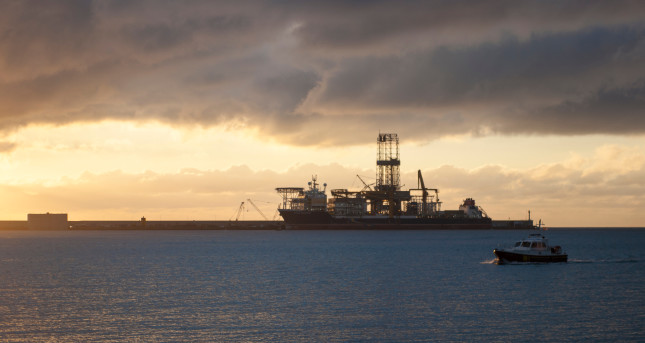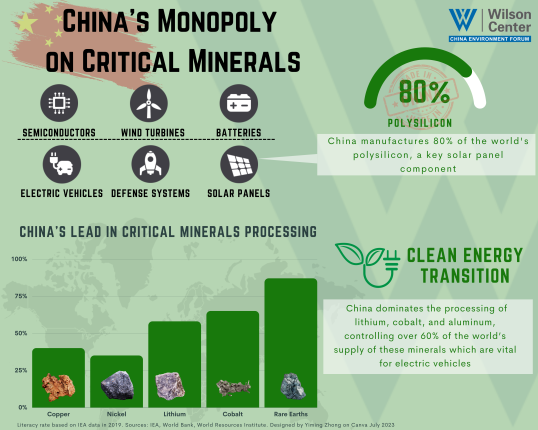-
China Leads the Race to the Bottom: Deep Sea Mining for Critical Minerals
August 17, 2023 By Yiming ZhongIn December 2022, at the Nansha District port in the Pearl River Delta, the China State Shipbuilding Corporation unveiled China’s first oceanographic drilling ship—capable of mining 10,000 meters deep. This launch showcased China’s rapid advances as a major player in the global race to extract critical minerals at the bottom of the ocean.
Chinese corporations dominate the mining and processing of critical minerals on land. (See Figure 2). Now, China’s eyes are set on lithium and cobalt in the deep sea. Large government investments are catapulting China into dominance within this new extractive industry, with Russia and South Korea following closely behind.
Yet a lack of information on critical mineral deposits—as well as scientific gaps on the ecosystem impacts of extraction—make deep-sea mining (DSM) a risky venture. At present, DSM is loosely regulated by nonbinding voluntary standards. So China’s dominance may set industry norms for the rush into deep sea exploration, without the creation of well-developed and harmonized standards via international consensus.
The Hunger for Critical Minerals
Critical minerals are integral to solar, wind, and EV batteries—the technologies that will help the world achieve the clean energy transition. To reach the Paris Agreement targets, a 2020 World Bank Report estimated that world production of lithium and cobalt must increase by more than 500% by 2050. Global demand for cobalt and nickel will be four times greater than the available sources on land by 2050.
Mineral shortages could slow the pace of clean energy technology deployment. Thus, many countries are vying to exploit the rich deposits of critical minerals on the ocean floor. Tellurium, used in high-performance solar panels, is 50,000 times more concentrated in seabeds than it is on land.
In the race against climate change, China’s near monopoly of critical mineral processing gives it the ability to rock western supply chains. (See Figure 2). Chinese ships are already seeking these minerals in the Pacific, Indian, and Arctic Oceans. Finding and extracting them could further solidify China’s lead in tapping new nickel, copper, cobalt, manganese, zinc, silver, and gold reserves.
Chinese government DSM targets have ignited heavy investments by state-owned enterprises in this space. The Jinhang Group, a private company, has attracted 20 million RMB in angel investment, and also signed a series of contracts to co-develop China’s first commercial deep-sea mining robot and intelligent mining control systems by 2025.
The United States Sidelined As China Dives Deep
China leads the deep-sea mining race with five DSM exploration contracts authorized by the International Seabed Authority (ISA). The ISA was established under UNCLOS to oversee and regulate DSM activities. At present, South Korea and Russia each hold three contracts.
As a non-ratifying state under UNCLOS, and a non-participant in the ISA, the United States is not even in the DSM race. And with no voice at the table, the US cannot shape environmental (or other) standards for DSM, thus driving American investment capital away from the emerging industry.
In June 2022, the United States launched the Partnership for Global Infrastructure and Investment with its G7 partners to build clean energy supply chains and signed the Minerals Security Partnership as steps to counteract Chinese dominance in this space. On July 13, 2023, the Biden Administration announced $32 million to support projects expanding critical mineral and rare earth mining and processing. Yet this investment will not cover deep-sea mining.
In July 2023, the 28th Session of the ISA Assembly to negotiate the regulation of DSM was held in Jamaica. The participating countries did not agree on any mining codes. China blocked discussions on marine ecosystem protection and—together with Russia and South Korea—opposed the DSM moratorium advocated by many international NGOs and a growing number of countries. China did agree to hold formal discussions on these topics next year.
Murky Guidance in the Muddy Ocean
Deep-sea mining could be a boon for job creation and clean energy technologies. However, mining in the sea poses similar environmental threats to those created by mining on land. Sarah Bedolfe, a marine scientist at Oceana, explained: “DSM corporations utilize powerful machines to extract minerals while sucking up entire habitats from the seabed – some of the methods are akin to vacuuming the seafloor or mountaintop removal.”
DSM excavation can even create a plume of sediment that smothers creatures on the seafloor, a particular concern given the recent discovery of more than 5,000 new deep-sea species in the Pacific’s Clarion-Clipperton Zone. An open letter from the IUCN Director General advocates for a DSM moratorium to protect these marine ecosystems.
For years, many national and multilateral agencies have advocated that all DSM industries and investments be bound by a global system of environmental, social, and governance (ESG) reporting regulations. The transparency mandated by ESG standards could help ensure responsible mining practices to preserve marine ecosystems, promote worker safety, and protect indigenous communities.
There is not yet a universal ESG standard for deep-sea mining. Instead, companies set their own ESG disclosure guidelines. Numerous rating agencies then evaluate the performance of mining companies using their own algorithms for weighing different performance categories and data.
“ESG guidance has not matured enough to formulate global standards that China, Russia, and other stakeholders are willing to agree to and comply with,” said Jeffrey Christian, who is Managing Director at CPM Group, and an expert on precious metals markets and commodities.
Some experts even argue that DSM is unnecessary. Dr. Monica Verbeek, a steering member of the Deep Sea Conservation Coalition and executive director of Seas at Risk, observed that some of the metals targeted by deep-sea mining are no longer critical for batteries due to technological advancements.
“Rather than spending millions of dollars to develop DSM technology,” said Verbeek, “we should invest in new battery technologies.” She also noted the huge potential of “urban mining” to recycle critical minerals in discarded electronic devices. In 2022 alone, some 5 billion mobile phones were thrown into landfills.
“The circular economy is a critical piece of the puzzle,” said Melissa Barbanell, Director of US-International Engagement at the World Resources Institute. “This can include the second use of battery materials, recycling of batteries and electronic waste, as well as re-mining tailings to obtain minerals deemed waste at earlier times.”
The World Bank predicts significant battery recycling could cut the demand for new mining of copper by 26%, nickel 23%, cobalt 15%, and lithium 26%, respectively, by 2050. Research is ongoing for alternative mineral sources from coal waste or hard-rock mine tailings.
The Race Continues
The ISA negotiations in July did not give China and other mining nations a green light to go beyond current explorations. Environmental groups were also encouraged as this partial moratorium for discussions to solidify ESG standards in 2024 and 2025 gives more time to build momentum for a full moratorium.
Despite the uncertainties of global deep-sea mining negotiations and the potential shifts in the market for critical minerals, China will still continue to move forward in the DSM race spurred on not only by central policy, but also by private investors.
The question for the rest of the world is can—or should—it catch up.
Yiming Zhong is a Master of Public Administration fellow (‘24) at Cornell University with a focus on Environmental Finance and Economic Development. He was a project management consultant at Porsche Consulting assisting automobile companies in making energy transitions and promoting business sustainability. He is a summer 2023 research assistant at the Wilson Center’s China Environment Forum, where he is focusing on critical mineral supply chains, sustainable finance, carbon trade, and renewable technologies.
Leading Photo Credit: A port Las Palmas de Gran Canaria. photo courtesy of Maria Pologrudov/Shutterstock.com.
Second Photo Credit: Magnificent golden deep-sea octopus, photo courtesy of Vladimir Turkenich/Shutterstock.com.
Sources: BBC, China Development Institute, Carnegie Endowment For International Peace, CBS News, CFR, China Daily, China Dialogue, China Marine Economy Expo, CME Group, Current Biology, Deep Sea Conservation Coalition, Institute of Oceanology – Chinese Academy of Science, ISA, International Maritime Organization, IUCN, Nature, Nature Portfolio, New York Times, Oceana, Politico, Rand Corporation, Shanghai Jiao Tong University, The Economist, The Guardian, The State Council of the People’s Republic of China, The Wall Street Journal, The White House, The Wilson Center, The World Bank, United Nations, USGS, World Resources Institute, WWF, XinhuaNet
Topics: biodiversity, China, China Environment Forum, environment, meta, minerals, Russia, South Korea, U.S.
 A Publication of the Stimson Center.
A Publication of the Stimson Center.







